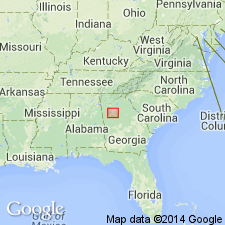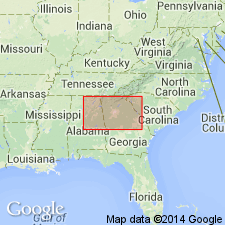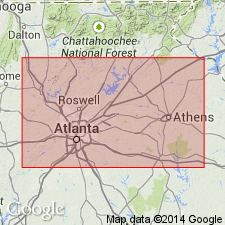
- Usage in publication:
-
- Big Cotton Indian Formation*
- Modifications:
-
- Named
- Dominant lithology:
-
- Gneiss
- Amphibolite
- Schist
- AAPG geologic province:
-
- Piedmont-Blue Ridge province
Summary:
The Big Cotton Indian Formation of the Atlanta Group is here named in the Newnan-Tucker synform near Atlanta, GA. It consists of biotite-plagioclase gneiss, hornblende-plagioclase amphibolite, and biotite-muscovite schist. Gradationally overlies the Clarkston Formation; gradationally underlies the Camp Creek Formation. Thickness is as much as 4,000 m. Age is Late Proterozoic and (or) early Paleozoic.
Source: GNU records (USGS DDS-6; Reston GNULEX).

- Usage in publication:
-
- Big Cotton Indian Formation*
- Modifications:
-
- Revised
- AAPG geologic province:
-
- Piedmont-Blue Ridge province
Summary:
The Big Cotton Indian Formation is removed from the Atlanta Group, here abandoned. It is the upper unit in the Clarkston slice of the Atlanta thrust sheet, and overlies the Clarkston Formation. It is composed of biotite-plagioclase gneisses, amphibolites, and schists, and may be a facies of the Clarkston. Age is Late Proterozoic to Early Ordovician(?).
Source: GNU records (USGS DDS-6; Reston GNULEX).

- Usage in publication:
-
- Big Cotton Indian Formation†
- Modifications:
-
- Abandoned
- AAPG geologic province:
-
- Piedmont-Blue Ridge province
Summary:
Detailed mapping during 1990-1993 of Big Cotton Indian Formation in area north of Soapstone Ridge shows that the rocks actually belong to the unnamed mixed unit of the allochthonous assemblage, which includes manganiferous quartzite (gondites). Around Soapstone Ridge (around sheath fold), it is actually Stonewall Gneiss. South of Soapstone Ridge (which includes type locality and section of Big Cotton Indian) it is actually Stonewall Gneiss intruded by light-colored metagranite (the "granite gneisses" in Big Cotton Indian in original description of Higgins and Atkins, 1981). Big Cotton Indian Formation is therefore abandoned and its rocks assigned to either the unnamed mixed unit of the allochthonous assemblage or Stonewall Gneiss. Report includes geologic map and correlation chart.
Source: GNU records (USGS DDS-6; Reston GNULEX).
For more information, please contact Nancy Stamm, Geologic Names Committee Secretary.
Asterisk (*) indicates published by U.S. Geological Survey authors.
"No current usage" (†) implies that a name has been abandoned or has fallen into disuse. Former usage and, if known, replacement name given in parentheses ( ).
Slash (/) indicates name conflicts with nomenclatural guidelines (CSN, 1933; ACSN, 1961, 1970; NACSN, 1983, 2005, 2021). May be explained within brackets ([ ]).

